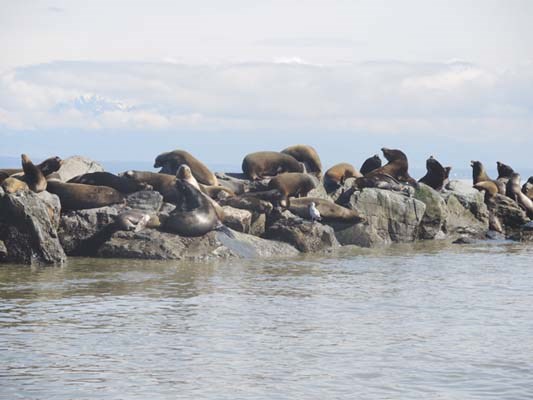A boat on a calm, sunny day provides prime seats to the symphony of natural sounds usually missed in the cacophony of city life.
The clear blue sky becomes an amphitheatre with perfect acoustics. A steady beat of the waves adds rhythm to the flute-like flutter of a birds song.
And suddenly, upon approaching the Steveston jetty, theres a whole lot more bassoon, as dozens of California sea lions take the stage.
Some languidly sprawl out on the rocks in the sun. Others hold their heads high with whiskers straight and eyes closed, attempting as dignified a pose as their large mass of blubber and small flippers will allow.
Every April and May, the male sea lions follow the fish to fatten up before joining the females in the rookeries for breeding season.
And every April and May, for the past three years at least, Bruce Livingston takes groups of people out on his six-person boat to see them.
Its a pretty special seasonal event we got here in Steveston, said Livingston, who owns Steveston Eco Tours Ltd. with his wife. Ill never get tired of it. Every day is different and every day is better than the last one.
This year, the California sea lions have been joined by the Stellar sea lions, a larger species, which is a good sign, according to Livingston.
It both indicates a growth in the Stellar population as they look for more areas to forage, and points to a balanced ecosystem.
Thereve been some good changes in the local waters, said Livingston, looking quite at home behind the wheel of his small boat.
Were seeing more and more species of the orca whale that feed on the harbour seal and sea lion. And were seeing them because theres more food. Its all about keeping nature in balance.
Despite the declining numbers of Chinook salmon down the Fraser River, Livingston said the significant presence of the sea lions means theres plenty other species of salmon to feast on.
In fact, the sea lion population has been steadily growing since 1975 when the Department of Fisheries and Oceans banned the hunting of the mammal.
I think it was the result of a more astute understanding of the environment, said Livingston.
They realized the trick is to increase the number of salmon rather than decrease the number of animals feeding on it.
After retiring from a 30-year career as a divorce lawyer, Livingston began Steveston Eco Tours to help people deepen this understanding of their surrounding environment and the Fraser River Estuary.
In an age of increasing industrial pressures, he hopes more exposure to the workings of the rivers natural ecosystem lead people to make maintaining this system more of a priority.
I want people to be able to see both sides, and some of these things you can only see once you get out on a boat, he said.
Theres the natural side and then all kinds of industrial development. Were at a tipping point here.
He points to improvements in sawmills and dredging as examples of recent attempts to balance industry and nature.
Sawmills used to emit a lot more chemicals and debris in the water, while dredging now works around the fishing season so as to not interrupt the salmon runs.
But ultimately for Livingston, just being able to share Richmonds collective backyard with others can be gratifying enough.
He sometimes makes special trips further out as was the case with a boat ride to the San Juan Islands in Washington last year.
A couple of English tourists had requested to spread their mothers ashes in the presence of orca whales.
Just at that point, one of the whales who had obviously been under water came right up beside the boat and kind of looked at our guests, he said.
Then she surfaced nearby and turned around and came up literally right beside the boat. That was a pretty special moment.
So if I get to get out, enjoy nature, and share it with all these people, its a wonderful day.



